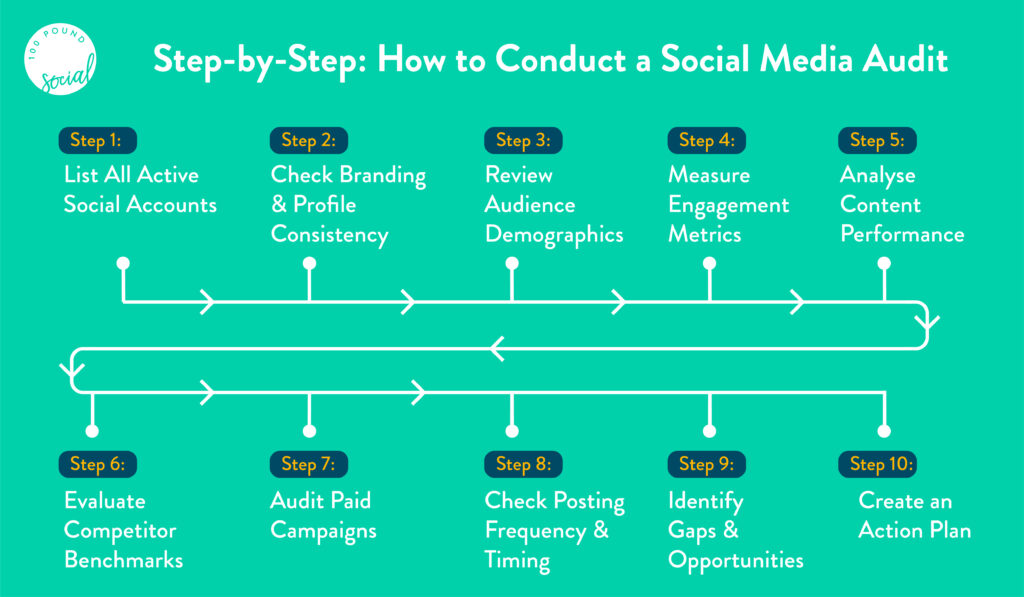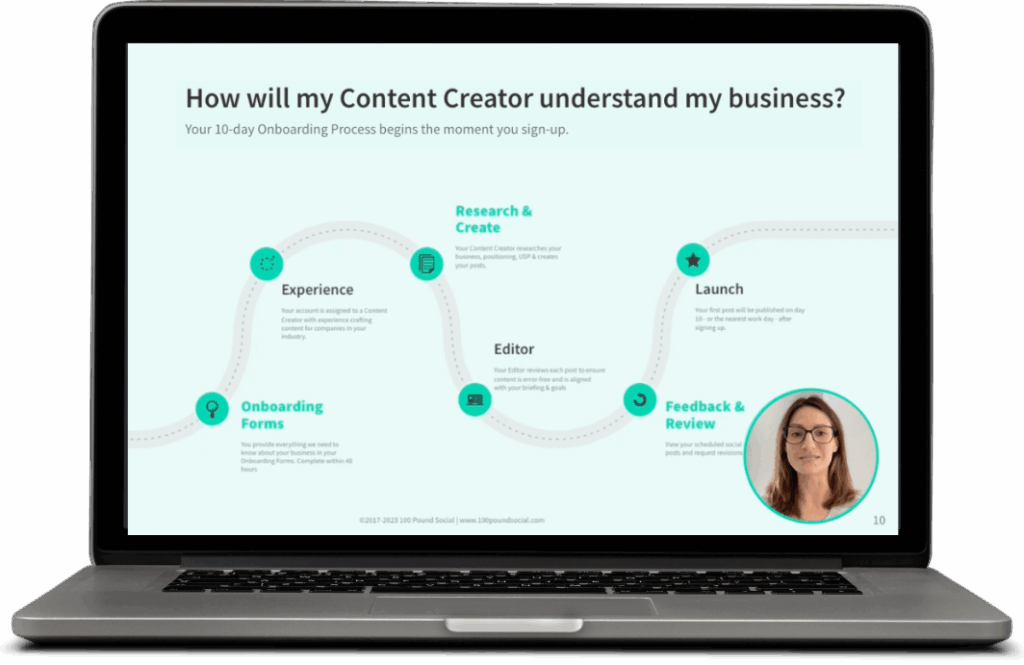Social media has become the heartbeat of modern business communication.
Yet many small and medium business owners find themselves posting content into the void, wondering if their efforts are actually attracting new clients and driving business growth.
This is where a social media audit comes in.
When done properly, a social media audit becomes your roadmap to improved client engagement, increased lead generation, and ultimately, better business outcomes.

What is a Social Media Audit?
At its core, a social media audit is your opportunity to step back and objectively evaluate your entire digital presence. It’s the difference between throwing content at the wall and crafting a targeted strategy that actually attracts potential clients and drives meaningful business results.
The primary purpose of this comprehensive review is to create a clear picture of your current social media landscape from a business development perspective.
Rather than relying on assumptions or gut feelings, an audit provides concrete data about how your content performs in attracting potential clients, who your audience really is, and where the biggest opportunities for business expansion exist.
This systematic evaluation helps you identify your strongest performing platforms for client attraction and content types that generate the most business enquiries, whilst also highlighting weaknesses that might be preventing potential clients from finding or engaging with your business.
Perhaps more valuable still, it reveals business growth opportunities you might never have considered—new platforms where potential clients are active, content formats that could boost client engagement, or competitor strategies you could adapt to attract more business.
The audit transforms your social media approach from reactive posting to proactive, data-driven decision-making that aligns directly with your client attraction and business development objectives.
Download Our FREE Social Media Strategy Template Here →
Step-by-Step: How to Conduct a Social Media Audit

Here are the steps to follow to conduct a social media audit the right way!
List All Active Social Accounts
Begin your audit by creating a comprehensive inventory of every social media account associated with your business.
This “detective work” often reveals more profiles than you initially remember—old Facebook pages created by former business partners, dormant X accounts, or experimental TikTok profiles that never gained traction with your target clients.
Document each account with platform names, usernames, follower counts, and the last posting date.
This complete picture helps you identify duplicate accounts that might be confusing potential clients or outdated profiles that could be damaging your business reputation. Get your house in order by deactivating or consolidating any accounts that no longer serve your client attraction goals.
Check Branding & Profile Consistency
Your social media profiles often serve as the first introduction potential clients have to your business. Walk through each active platform and evaluate whether your branding tells a cohesive story that builds trust with prospective clients.
Check that your company logos appear consistently, your biographical information matches across channels, and your contact details are up to date.
Inconsistent branding creates confusion and undermines trust with potential clients. Your LinkedIn profile shouldn’t look like it belongs to a completely different business than your Instagram account. This consistency extends beyond visuals to include your tone of voice, messaging, and overall brand personality that appeals to your target clients.
Review Audience Demographics
Understanding who actually engages with your content can be eye-opening for business owners.
Many operate on assumptions about their potential clients that don’t align with reality. Each platform’s built-in analytics provides detailed demographic information about your followers and those who interact with your content.
Examine age ranges, geographic locations, industries, and engagement patterns to determine if you’re reaching potential clients in your target market.
You might discover that your Instagram followers work in different industries than you typically serve, or that your LinkedIn audience includes business owners primarily based in regions where you don’t offer services.
Measure Engagement Metrics

Move beyond vanity metrics like follower counts and focus on engagement indicators that actually impact your business development efforts.
Track likes, shares, comments, click-through rates, and most importantly, client enquiries and conversions. A post that generates meaningful conversations with potential clients delivers far more value than one that receives dozens of passive likes from irrelevant connections.
Analyse your metrics over time to identify trends and patterns that correlate with business growth.
Consider these questions:
- Are your engagement rates with potential clients improving or declining?
- Which days of the week generate the best response from your target market?
Understanding these patterns helps optimise your client attraction strategy.
Analyse Content Performance
Review your recent posts to identify what resonates most strongly with potential clients in your target market.
Look beyond individual posts to identify broader patterns—perhaps your case studies consistently outperform general business tips, or your client success stories generate more engagement than industry news.
Pay particular attention to content that drives website traffic or generates business enquiries. These posts provide valuable insights into what motivates potential clients to take action and reach out to discuss working with your business.
Evaluate Competitor Benchmarks
Other business owners in your industry provide valuable intelligence about what works for client attraction.
Identify three to five businesses similar to yours and analyse their social media presence.
Which platforms are they using most effectively to attract clients? What types of content generate strong engagement from their target market? How frequently do they post business-focused content?
This competitive analysis isn’t about copying their client attraction strategy—it’s about identifying opportunities for differentiation and learning from their successes and mistakes.
You might discover untapped platforms where competitors aren’t actively pursuing clients, or content gaps you could fill to attract business in your market.
Audit Paid Campaigns
If you’re investing in social media advertising to attract clients, scrutinise the return on investment for each campaign. Which advertisements are driving actual business enquiries versus those that simply generate likes and follows from people who will never become clients?
This analysis helps you optimise your advertising budget and focus resources on channels that deliver measurable business outcomes.
Review your targeting parameters, ad creative performance, and conversion tracking to ensure every pound spent contributes to attracting potential clients and growing your business.
Check Posting Frequency & Timing
Timing can make or break your content’s performance with potential clients. Review when business owners and decision-makers in your target market are most active on each platform and evaluate whether your posting schedule aligns with these patterns.
There’s little point in sharing valuable content when potential clients are offline or focused on other business activities.
Consider both time-of-day and day-of-the-week variations. B2B business owners often engage with content during business hours on weekdays, whilst some industries might find certain times more effective for reaching their specific client base.
Identify Gaps & Opportunities
Look systematically for gaps in your current client attraction approach.
Are there platforms where potential clients in your industry are active but you don’t maintain a presence? Have you been focusing on one content format when your target clients might prefer variety?
Perhaps you’ve been concentrating solely on Facebook when business owners in your industry are more engaged on LinkedIn, or maybe you’ve been posting only static images when client case studies or detailed testimonials in text format might generate better results for attracting new business.
Create an Action Plan
Transform your audit findings into a clear, actionable strategy focused on client attraction and business growth.
Set specific, measurable goals for each platform related to generating business enquiries, define your content themes and formats that appeal to potential clients, establish optimal posting schedules for reaching business decision-makers, and identify the key performance indicators you’ll track moving forward.
Your action plan should be detailed enough that any team member could execute it effectively to support your client attraction efforts, yet flexible enough to adapt as you learn what works best for attracting your specific target clients and growing your business.
Tools to Help With a Social Media Audit
The right tools can transform a potentially overwhelming audit process into a manageable, systematic review that supports your business development goals.
For business owners working with limited budgets, spreadsheets combined with each platform’s native analytics provide substantial insights without additional financial investment.
However, dedicated social media management and analytics tools can significantly streamline the process whilst providing deeper insights into client behaviour and engagement patterns.
Platforms like HeyOrca, Hootsuite, Sprout Social, and Buffer offer dashboards that consolidate data from multiple channels, making it easier to spot trends in client engagement and compare performance across platforms.
For UK business owners, these tools offer particular value in competitor analysis and scheduling optimisation for reaching potential clients.
Many provide insights into optimal posting times for UK business audiences and can track competitor activity focused on client attraction across multiple platforms simultaneously.
Get Hot Leads With Our LinkedIn Lead Gen Plan, From £254/mo →
Common Mistakes to Avoid
One of the most significant mistakes business owners make is maintaining a presence on platforms where their potential clients simply aren’t active.
Just because a particular social network receives lots of attention doesn’t mean it’s right for attracting clients to your business. If you’re targeting professional services clients, TikTok might not deliver the results that LinkedIn would provide for business development.
Another critical error involves focusing exclusively on vanity metrics.
A thousand followers who never engage with your content or enquire about your services provide less business value than a hundred highly engaged potential clients who regularly interact with your brand and express genuine interest in working with your business.
Many business owners also make the mistake of treating all platforms identically when trying to attract clients. Each social network has distinct cultures, content preferences, and optimal strategies for business development.
What works brilliantly on X for client attraction rarely translates directly to LinkedIn or Instagram without significant adaptation.
Finally, conducting audits sporadically rather than systematically undermines their effectiveness for business growth.
Social media landscapes shift rapidly, and client preferences change regularly. Business owners who audit annually often find themselves operating on outdated assumptions that no longer attract potential clients or drive business results.
Key Takeaways
Regular social media audits represent more than best practice recommendations for business owners—they’re fundamental requirements for sustainable client attraction and business growth in today’s digital landscape.
The pace of change in social media means that strategies effective for attracting clients six months ago might be completely irrelevant today.
The audit process provides clarity about what’s working for client attraction, eliminates wasteful activities, and identifies high-impact opportunities for business expansion.
More importantly, it transforms social media from a time-consuming obligation into a strategic business asset that drives measurable client acquisition and business growth.
Make social media audits a quarterly commitment. This frequency keeps you current with changing platform algorithms, shifting client preferences, and evolving competitor strategies whilst ensuring your social media efforts remain aligned with your broader client attraction and business development objectives.
Next Steps
Conducting thorough social media audits and implementing strategic improvements requires considerable time and expertise—resources that many business owners simply don’t have whilst managing client relationships and growing their businesses.
This is precisely where 100 Pound Social can transform your approach to client attraction. Our UK-based team specialises in creating high-quality content and generating LinkedIn leads, allowing you to focus on serving clients and growing your business whilst experts handle your social media strategy.
Since 2017, we’ve helped over 1,000 business owners across diverse industries develop effective social media strategies that drive real client acquisition results.
Our clients consistently report increased turnover, growing social media followings that convert to business enquiries, and most importantly, signing new clients through their improved online presence.
Ready to transform your social media from a time drain into a client-generating asset?
Join a free 15-minute demo to discover how we can create expert content for your business from just £100 per month. Our comprehensive approach includes strategic planning focused on client attraction, content creation that resonates with potential clients, and performance optimisation—everything you need to turn your audit findings into sustainable business growth.
Book your demo today and let us show you how professional social media management can accelerate your client attraction success whilst giving you back valuable time to focus on serving your clients and growing your business.







